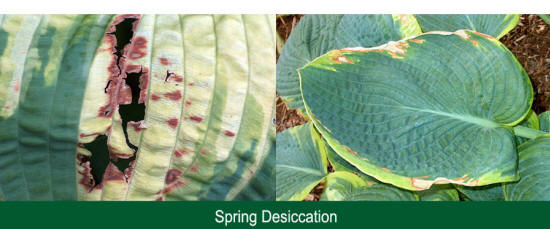One of the
"mysteries" of hostadom is that certain large,
blue-green hostas with yellow marginal or medial
(center) variegation suffer from a
syndrome called spring desiccation burn. One of the
all-time classic cultivars, H. 'Frances Williams'
was among the first to be noted as experiencing this
type of damage. Other
Hosta sieboldiana-type
plants such as H. 'Golden Sunburst' and H. 'Borwick
Beauty' are also severely impacted. A similar plant, H.
'Olive Bailey Langdon' is only slightly affected.
Others of this type do not seem to be bothered at
all.
What happens is
that by early summer, parts of the yellow variegation
become translucent and then turn brown to rusty-orange
in color.
The blue-green tissue of the leaf is never affected.
Also, similar types of plants that have white instead of
yellow margins such as H. 'Northern Halo' and H.
'Northern Exposure' are not affected.

Over the years, I
have grown H. 'Frances Williams' in 4 or 5 different
locations in my landscape. These were in differing
levels of shade and water conditions. Each one would
look different from all of the others in terms of how
much spring desiccation burn they suffered. Some would
be severely bothered one year but hardly blemished the
next.
The theory is that
the problem is "physiological" which means that it is
not caused by a disease or insect. Rather it seems to be
caused when the leaves are rapidly expanding in the
early spring and the night temperatures drop near or
below freezing. High winds or direct sunlight on the
plant the next day causes the drying and death of the
leaf tissue. The dead tissue then turns a rusty orange
color.
Here are some
listings of hosta cultivars that a)
Suffer Desiccation Burn or b)
Resist Desiccation Burn.



